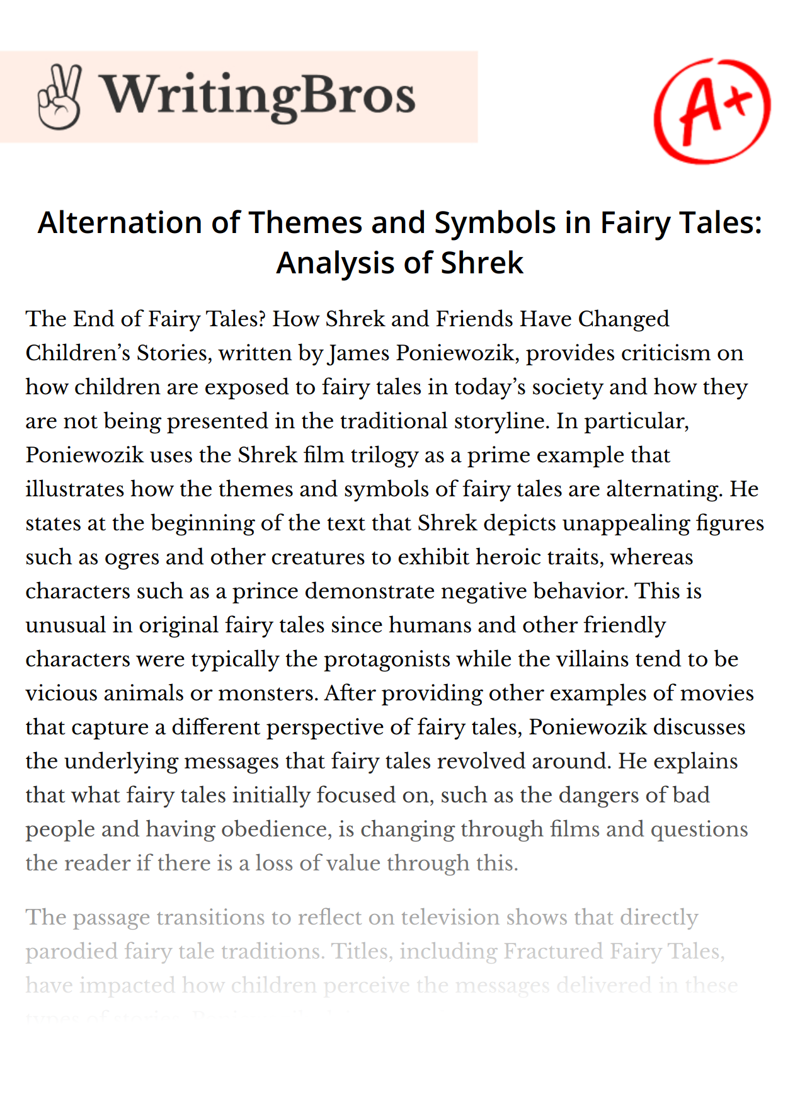Alternation of Themes and Symbols in Fairy Tales: Analysis of Shrek

The End of Fairy Tales? How Shrek and Friends Have Changed Children’s Stories, written by James Poniewozik, provides criticism on how children are exposed to fairy tales in today’s society and how they are not being presented in the traditional storyline. In particular, Poniewozik uses the Shrek film trilogy as a prime example that illustrates how the themes and symbols of fairy tales are alternating. He states at the beginning of the text that Shrek depicts unappealing figures such as ogres and other creatures to exhibit heroic traits, whereas characters such as a prince demonstrate negative behavior. This is unusual in original fairy tales since humans and other friendly characters were typically the protagonists while the villains tend to be vicious animals or monsters. After providing other examples of movies that capture a different perspective of fairy tales, Poniewozik discusses the underlying messages that fairy tales revolved around. He explains that what fairy tales initially focused on, such as the dangers of bad people and having obedience, is changing through films and questions the reader if there is a loss of value through this.
The passage transitions to reflect on television shows that directly parodied fairy tale traditions. Titles, including Fractured Fairy Tales, have impacted how children perceive the messages delivered in these types of stories. Poniewozik claims people, especially young kids, are exposed and more interested in the parodies and alternations of fairy tales instead of the original stories themselves. Shrek is mentioned again, and Poniewozik argues that children in today’s world are more likely to learn “Puss in Boots” the character through the movie and not through the actual story of the cat. The passage stresses the large-scale effect of these parodies by saying, “Shrek didn’t remake fairy tales single-handed; it captured, and monetized, a long-simmering cultural trend” (394, Poniewozik). He later goes into depth with this argument, concluding that everybody, not just children, is subjected to accept parodies rather than original fairy tales. He demonstrates this by revealing how the Shrek trilogy contains comedic elements that please adults and explains how old fairy tales are simply boring to modern times. Numerous instances of how the movies relate to adult life is given by the context, “More broadly, each movie gives Shrek and Fiona an adult challenge: in the first to find love and see beyond appearances; in Shrek 2 to meet the in-laws; in Shrek the Third, to take on adult responsibility and parent-hood (Shrek has to find a new heir to the throne of Far Far Away, or he will have to succeed the king)” (395, Poniewozik).
The End of Fairy Tales? emphasizes the decisions moviemakers execute and how they structure parodies of fairy tales. Poniewozik wrestles with the legacy of Disney and elaborates more on Shrek. He admits that these parodies appeal to his own humor and why one should not ignore the themes of these parodies. According to the passage, “I feel like a traitor to my fellow parents for even saying this. These movies are made in part of me: a socially progressive, irony-friendly Gen Xer with rug rats” (396, Poniewozik). The movie, Stardust, is mentioned to support his case that parodies have many positive aspects. He claims that the astonishing settings and magical atmosphere truly makes the movie an enjoyable film.
My own view, however, is that there is a loss of value through the idea that fairy tales’ initial impression has started to fade out with the addition of movie remakes of these classic works. This has changed the view for all fairy tales as they are being changed as time goes on. Children are gaining a perspective that is enforced by movie critics and influences more so than the original author’s point of view. I always go by the saying that “The book is always better than the movie”, which applies perfectly to what Poniewozik states about the Shrek fairy tales in comparison to modern movies about the text. Without the correct perspective from the author, it forces generations to have completely different ideas about the main moral behind each individual fairy tale.
Cite this Essay
To export a reference to this article please select a referencing style below

